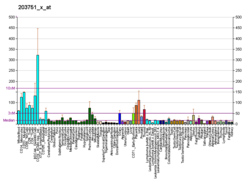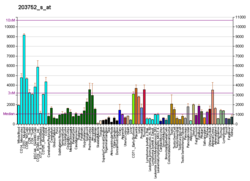| JUND |
|---|
 |
|
| Structures disponibles |
|---|
| PDB | Recherche d'orthologue: PDBe RCSB |
|---|
|
|
| Identifiants |
|---|
| Aliases | JUND |
|---|
| IDs externes | OMIM: 165162 MGI: 96648 HomoloGene: 3910 GeneCards: JUND |
|---|
| Position du gène (Homme) |
|---|
 | | Chr. | Chromosome 19 humain[1] |
|---|
| | Locus | 19p13.11 | Début | 18,279,694 bp[1] |
|---|
| Fin | 18,281,622 bp[1] |
|---|
|
| Position du gène (Souris) |
|---|
 | | Chr. | Chromosome 8 (souris)[2] |
|---|
| | Locus | 8 B3.3|8 34.15 cM | Début | 71,151,599 bp[2] |
|---|
| Fin | 71,153,265 bp[2] |
|---|
|
| Expression génétique |
|---|
| Bgee | | Humain | Souris (orthologue) |
|---|
| Fortement exprimé dans | - cardia
- veine cave
- mamelon
- paraflocculus of cerebellum
- pylore
- Médullaire rénale
- canal galactophore
- trachée
- Veine saphène
- Brodmann area 10
|
| | Fortement exprimé dans | - granulocyte
- glande surrénale
- moelle osseuse
- îlot de Langerhans
- iléon
- éminence ganglionnaire
- cerebellar cortex
- primary visual cortex
- striatum of neuraxis
- vessie
|
| | Plus de données d'expression de référence |
|
|---|
| BioGPS | 

 | | Plus de données d'expression de référence |
|
|---|
|
| Gene Ontology |
|---|
| Fonction moléculaire | - liaison ADN
- sequence-specific DNA binding
- DNA-binding transcription factor activity
- transcription coactivator activity
- liaison protéique
- liaison enzymatique
- double-stranded DNA binding
- RNA polymerase II cis-regulatory region sequence-specific DNA binding
- transcription factor binding
- DNA-binding transcription activator activity, RNA polymerase II-specific
- DNA-binding transcription factor activity, RNA polymerase II-specific
- nuclear receptor binding
| | Composant cellulaire | - protein-DNA complex
- chromatine
- noyau
- transcription factor AP-1 complex
- complexe macromoléculaire
- nucléoplasme
- transcription regulator complex
| | Processus biologique | - cellular response to calcium ion
- response to cytokine
- regulation of transcription, DNA-templated
- response to organic cyclic compound
- response to light stimulus
- regulation of cell death
- vieillissement
- response to peptide hormone
- negative regulation of transcription by RNA polymerase II
- transcription by RNA polymerase II
- transcription, DNA-templated
- régulation du cycle cellulaire
- cellular response to hormone stimulus
- positive regulation of osteoblast differentiation
- regulation of cell population proliferation
- rythme circadien
- positive regulation of cell differentiation
- osteoblast development
- response to radiation
- response to cAMP
- response to lipopolysaccharide
- response to mechanical stimulus
- regulation of transcription by RNA polymerase II
- positive regulation of transcription by RNA polymerase II
- response to organic substance
| | Sources:Amigo / QuickGO |
|
| Orthologues |
|---|
| Espèces | Homme | Souris |
|---|
| Entrez | | |
|---|
| Ensembl | | |
|---|
| UniProt | | |
|---|
| RefSeq (mRNA) | | |
|---|
| RefSeq (protéine) | | |
|---|
| Localisation (UCSC) | Chr 19: 18.28 – 18.28 Mb | Chr 8: 71.15 – 71.15 Mb |
|---|
| Publication PubMed | [3] | [4] |
|---|
|
| Wikidata |
| Voir/Editer Humain | Voir/Editer Souris |
|
Le JunD est une protéine avec un rôle de facteur de transcription. Son gène est le JUND situé sur le chromosome 19 humain.
Rôles
Il intervient dans l'angiogenèse tumorale[5], la différenciation cellulaire et l'apoptose[6]. Il est protecteur vis-à-vis du stress oxydatif en augmentant l'expression de certaines protéines, comme la ferritine[7]. Il freine les altérations de la fonction de l'endothélium vasculaire des à l'âge[8].
Chez le rat, il intervient dans la spermatogenèse[9]. Par ailleurs, la ménine inhibe son activité, supprimant par ce biais la différenciation des ostéoblastes[10].
Son expression est réduite en cas d'insuffisance cardiaque terminale[11].
Notes et références
- ↑ a b et c GRCh38: Ensembl release 89: ENSG00000130522 - Ensembl, May 2017
- ↑ a b et c GRCm38: Ensembl release 89: ENSMUSG00000071076 - Ensembl, May 2017
- ↑ « Publications PubMed pour l'Homme », sur National Center for Biotechnology Information, U.S. National Library of Medicine
- ↑ « Publications PubMed pour la Souris », sur National Center for Biotechnology Information, U.S. National Library of Medicine
- ↑ Gerald D, Berra E, Frapart YM et al. JunD reduces tumor angiogenesis by protecting cells from oxidative stress, Cell, 2004;118:781–794
- ↑ Hernandez JM, Floyd DH, Weilbaecher KN, Green PL, Boris-Lawrie K, Multiple facets of junD gene expression are atypical among AP-1 family members, Oncogene, 2008;27:4757–4767
- ↑ Tsuji Y, JunD activates transcription of the human ferritin H gene through an antioxidant response element during oxidative stress, Oncogene, 2005;24:7567–7578
- ↑ Paneni F, Osto E, Costantino S et al. Deletion of the activated protein-1 transcription factor JunD induces oxidative stress and accelerates age-related endothelial dysfunction, Circulation, 2013;127:1229–1240
- ↑ Thépot D, Weitzman JB, Barra J et al. Targeted disruption of the murine junD gene results in multiple defects in male reproductive function, Development, 2000;127:143–153
- ↑ Naito J, Kaji H, Sowa H, Hendy GN, Sugimoto T, Chihara K, Menin suppresses osteoblast differentiation by antagonizing the AP-1 factor, JunD, J Biol Chem, 2005;280:4785–4791
- ↑ Pollack PS, Pasquarello LM, Budjak R, Fernandez E, Soprano KJ, Redfern BG, Goldman B, Differential expression of c-jun and junD in end-stage human cardiomyopathy, J Cell Biochem, 1997;65:245–253
 Portail de la biologie cellulaire et moléculaire
Portail de la biologie cellulaire et moléculaire  Portail de la médecine
Portail de la médecine

 Portail de la biologie cellulaire et moléculaire
Portail de la biologie cellulaire et moléculaire  Portail de la médecine
Portail de la médecine 




















